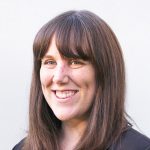Seraphina's paintings speak about Jesus in her own way
Seraphina swishes black paint onto the canvas as she speaks.
“We always use black for the background,” she says.
She is painting on the ground of what will soon be Ti Tree Station’s outdoor church (the other name for this community is Nturiya). The outdoor church has just one wall, and is surrounded by the community.
As she paints, Seraphina remembers being in church as a child.
“Our families would seat us in the front, all of us children, and they used to sing lovely hymns.”
Seraphina is a Warlpiri woman. Like many in her community, she speaks several Indigenous languages including Warlpiri (her first language) and Anmatyerr. Her family learned about Jesus from Lutheran missionaries who came to her community in Ti Tree Station, a small community in the Northern Territory, 17kms west of Ti Tree and the Stuart Highway, 193 km north of Alice Springs.
She says that she forgot about God and the hymns she used to sing in church, but “as I became an adult, I thought that someone was talking to me.” She thought that it must be God talking to her. “He saved me,” she said.
Still painting, she describes her strokes as she paints “Jesus dying on the cross for my sins. He has shown us that he loves us and that we are his children. And that he has made a way for us.”
“When we do our painting, we don’t just paint a picture of the face when we paint people … we represent them using U’s.”
On her painting now are three big ‘U’s’, in different colours. “Blue is God, the red is Jesus and the yellow is the holy spirit. And God, all in one.”
Seraphina paints coloured dots raining down from the ‘U’s’. “This is their love flowing down to us, and they are in the clouds up there in heaven. I can feel [their love] because they are with us.”
She is passionate about God. She says she gets her passion from God’s love, but also because she wants to walk in the footsteps of her brother, who was an evangelist before he died. She particularly wants to tell women about Jesus.
“I want to lead the way for women around here. So if they see me, that I’m doing things like this and working for the Lord, I’m sure that they’ll follow me,” she said. But she’s also concerned for the young people in her community.
“Jesus always says in the Bible that we should never leave the kids out. We should always encourage them,” she says. It’s a big reason why she likes to paint – to tell stories for the children. And also, why she decided to become a Bible translator.
“I’m always talking around the campfires telling stories to the young ones.
“We are losing our old people very fast. We’ve only got a very few left. That’s why I put myself into translation. The younger generation don’t really understand,” she said.
Seraphina works with David Strickland, a Bible translator from AuSIL who is working on a mini-Bible for the Anmatyerr people who live in Ti Tree and surrounding areas. Bible Society Australia has published Anmatyerr translations of the Gospel of John and a picture book called God’s Story for the Outback, and the Book of Mark, Acts, 1 & 2 Thessalonians, 1 & 2 Timothy, Titus, Philemon, James also exist in language. Translation for the Book of Luke has just been completed.
Seraphina knows the power of God’s word in her own life, and says it makes her happy to hear his word in her own language.
“[It’s like] knowing God is here with us and that we can feel safe,” she says.
“If the Bible is just written in English, there would be no understanding. But with translators, everything is made easier. People can talk about it, listen. It’s good to hear the story spoken and read in language. That is very important in our lives.”
Bible Society Australia is running a campaign to help our Indigenous brothers and sisters like Seraphina share the Bible their way, in their words – so they can pass it on to future generations through art, storytelling and in their lives every day. Will you help Indigenous Christians share the Bible their way, in their words?
Make a Donation
Aboriginal and Torres Strait Islander peoples have shared stories for generations. More than half of Indigenous people are Christians*, although most have never heard the Bible in their language. There’s only one full Bible in an Australian language, Kriol.
There’s an urgent need to help our Indigenous brothers and sisters share the Bible their way, in their words – so they can pass it onto future generations through art, storytelling and in their lives every day. Will you help Indigenous Christians share the Bible their way, in their words?

